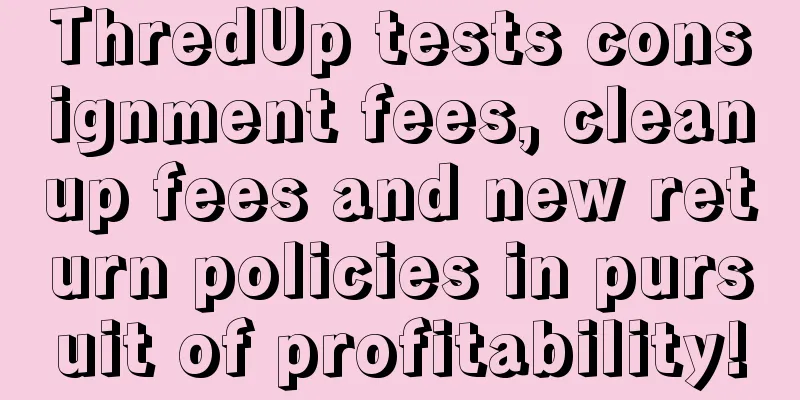The most complete guide to opening a Shopify store, you will know everything after reading it

|
Previously, we launched a 30-day series of tutorials on opening a Shopify store, with a total of 30 articles. It would be too troublesome for everyone to read them one by one, so today we are going to release a complete tutorial so that after reading one article, you will know how to select products, create a Shopify store, set up a store, etc. Table of contents Step 1: Find a profitable product niche Step 2: Choose a product supplier Step 3: Create a Shopify account Step 4: Create a Shopify store Step 5: Add products Step 6: Set up payment method Step 7: Set shipping costs Step 8: Gift card and discount code settings Step 9: Customer Service Settings Step 10: Store launch Simply put, Dropshipping is a way of order fulfillment. Sellers do not need to reserve inventory. All they have to do is market the products. When consumers place an order, the supplier will ship the goods in the name of the seller - that is, dropshipping. The advantages of dropshipping include:
When doing dropshipping, sellers are very dependent on suppliers, and the two parties are in a relationship of mutual support, so finding a reliable and high-quality supplier is the key. There are many high-quality suppliers, and you can find them on platforms such as Spocket or AliExpress. AliExpress was launched in 2010, and countless sellers have created their own history on it. There are many tutorials abroad on how to set up Dropshipping through AliExpress. Spocket is a foreign dropshipping platform, mainly active in the United States and the European Union, building a bridge between sellers and suppliers. You can’t just pick any product to put on the shelves when opening a store. In order to maximize the output of your store, you need to find a niche product before opening a store. You can only achieve high sales if you select products well. Here are some suggestions for product selection:
Because it is dropshipping, you need to consider the cost of placing an order from the supplier. If the product price is within this range, you can increase the price to maximize your profit, and the selling price will not be too high.
High-end customers have strong purchasing power. The middle class with an annual income of $41,000 to $132,000 is the ideal customer. They are more willing to spend money on the products they like.
The market dominated by brands has almost been monopolized, so there are more opportunities when choosing non-branded products. Now that we have talked about the product selection criteria, let’s introduce the product selection tools. Google Keyword Planner Google is the world's largest search engine, and websites that rank high have large traffic and high conversion rates. So you can use the keyword data in Google Keyword Planner to identify favorable products. Things this tool can do include:
In fact, it is just by checking the keywords to see whether the search volume of this product is large and whether the product is easy to sell. Log in to Google Keyword Planner with your Google account. After logging in, click “Search for new keywords using a phrase, website or category”: Then enter the product name. For example, if you want to sell watches, enter "wrist watches" and you can narrow it down by product category and region. Pulling down will display other keywords related to the search term, such as "wrist watch for men". SEM Rush Google Keyword Planner provides keyword search volume, but it won’t tell you whether the ranking competition is fierce. The SEM Rush tool provides keyword ranking difficulty data.
Although it is a paid tool, there is also a free account, but the number of keywords that can be searched each day is limited.
If you want to know how difficult it is to rank for a keyword, just check the keyword density (KD). The lower the density, the easier it is to rank for this word. Taking the word “wrist watch for men” as an example, the KD is 90.71, which shows that the ranking competition is very fierce. You can choose other words with low density to rank your Shopify store. Click KD and sort it from small to large. You will see that the density of the word "antique wrist watches for men" is 67.03, which means there is little competition. So let's take the product as the store product and search it on Spocket and AliExpress: There are many related products on Spocket. The following is the search result of AliExpress: The results from AliExpress show that in addition to pocket watches, there are also wristwatches, and the prices of the products are mostly between US$1 and US$20, which meets the product selection criteria we just mentioned. SEM Rush data shows that the search volume for "antique wrist watches for men" is 20. Although the search volume is important, our goal is to find keywords that are easier to rank for. If we choose keywords with a search volume density of more than 85, it will be more difficult to get a high ranking. After selecting the products, all you have to do is find suppliers. You can use the two platforms of AliExpress and Spocket. Shopify recommends AliExpress as the preferred source of goods for dropshipping. First, search for "dropshipping" on AliExpress: Click on “dropshipping watches” to see the results: The prices of the products in the search results are mostly between $1 and $20. Below the prices, you can see the product sales and ratings. The higher the rating, the more reliable the product/seller is. Also, try to find products with many user ratings. If there are only a few user ratings, you can't tell whether the product is good or bad. Be careful to choose non-branded products, because it is difficult to distinguish the authenticity of branded products on AliExpress, so it is better not to choose brands. Below the product rating is the seller rating, represented by diamonds. In addition to the product, the seller rating is also very important. The higher the rating, the more reliable the seller is. A rating above 95% indicates that the seller is reliable: Through the above steps, you can narrow down the scope of suppliers step by step, and then communicate with them to understand their feedback. Let’s say you decide to sell the following watch on your Shopify store:
The rating is 4.7, with 87 user ratings and 94 orders, which shows that the product has great sales potential. Now we need to evaluate our pricing. Let’s go to Amazon and find similar products: The screenshot shows that the price range is between 20-200. In order to ensure the competitiveness of the product, we can set the price at 20 US dollars. It is best to do a test purchase of a supplier to see if the purchase process is smooth and check the product. This will also give you a better idea of the customer's reaction after purchasing the product in the future. Step 3: Create a Shopify store Now that you have found your products, it’s time to create a store. You can create a Shopify account for free, and you will need to fill in your email address, password, etc.:
After successfully registering, Shopify will provide 4 options for you to choose from:
If you don't have any experience, click "I'm not selling products just yet" and select 0 for your current revenue. Then you need to complete your personal information, and after submitting it, you will be redirected to the backend panel. Shopify Plan After creating your account, you need to subscribe to a plan to unlock Shopify's advanced features. Although you have a 30-day free trial, it's still better to decide on a plan as soon as possible to avoid confusion later. To choose a plan, click the "Select a Plan" button:
There are three plans to choose from – Basic Shopify, Shopify, and Advanced Shopify. As a beginner, you can choose the Basic Shopify plan first, and then change the plan when your store starts to take off. Step 4: Create a Shopify store Creating a Shopify store is divided into 4 stages
Buying and setting up a domain First, click "Domain" in the store backend. Shopify will assign you a domain name like this for free: http://xxx.myshopify.com. If you want to consider building your own brand awareness, you can purchase a domain name. GoDaddy and Namecheap both provide domain name purchase services. GoDaddy is the world's largest domain name service provider. Namecheap's prices and services are more competitive:
The cost of a .com domain name is $10.98/year, and .net is $14.98/year. When you purchase a domain name, you will get WhoisGuard for free, which can hide your identity. Or you can buy a domain directly from Shopify. Set up email forwarding To set up email forwarding, first click on the Domain page, then click on the domain name you have purchased:
The next page will show two email addresses with your domain name as the suffix: info@ and sales@. To change the forwarding address of Shopify store emails, you can change it here. You can also delete and add email addresses here. Determine the store theme Sellers need to think carefully about the design of their store, because it is closely related to the customer experience. If customers like your design style, the probability of placing an order will increase. The theme is part of the store design style, and Shopify provides free themes. To change the store theme, click on the backend Themes: A new window will display a variety of themes, some free and some paid. Sellers who are just starting out can choose a free theme: After selecting a theme, if you want to apply it to your store, click "Install Theme". If you want to fully apply the theme, click "Publish as my store's theme". If you do not want to overwrite the current theme, click "install as an unpublished theme". After completion, a "Go to your theme manager" button will appear. Click it to make customized modifications yourself. After clicking, page sections will appear in the sidebar, and clicking will display various options for you to choose. If you don't want certain sections, click the "Delete section" button. Set up the required pages for your store You need to add some pages to your store yourself. It is recommended that the store must have the following pages:
To create a page, click Pages under Online Store: Click the "Add page" button and you can add a new page to your store. About page settings guide: Since you need organic traffic from search engines, you need to edit the SEO permissions of the page. Scroll down on the settings page and click "Edit website SEO". Edit the meta title and description, preferably something that will attract users to click. Click Save when you are done. After you have created it, you need to add the page to the website navigation bar for easy viewing by users. After saving, click "add it to your store's navigation". There are top and bottom navigation bars to choose from. For example, if you want to add it to the top navigation, click Main Menu. After completing the settings, click "Save Menu". To quickly create a refund policy, privacy policy, and other pages, click Settings > Checkout, find the Refund, Privacy, and TOS statements section, and click Generate content: Once completed, it will be displayed in the footer of the checkout page. Some templates may not be suitable for the actual situation, it is recommended to edit accordingly. Step 5: Add products Click “Add product”: Then fill in the product details: The product description can be edited based on the content provided by the supplier. The description should be attractive to customers: On the right side of the page is the "Organization" information, where you can edit information such as product type, supplier, collection, and tags. Collection means putting products together with similar products to show them to customers, and tags make it easier for users to search for your products. Pull down to upload product pictures. To improve the conversion rate, you must ensure that the uploaded pictures are of high quality: Then for the price section, enter the price you set, and leave the inventory blank:
Since the delivery is handled by the supplier, this part can be left blank. Remember to discuss the delivery issues with the supplier:
Then enter the product attributes, enter the product color, size, etc.: Finally, you will edit the information that your product page will show on search engines. Click "Edit website SEO" and enter your title and description, as well as your URL. If there is space in the title, consider adding your store name at the end. Make your description as detailed as possible, making full use of the 160 characters. Keep the URL as short as possible. You can also consider keyword optimization for this page, such as adding keywords with less competition found by SEMrush to improve the ranking. After completion, click Save. The same steps are followed for adding other product pages. Automatically add products to collections: Click Collections and enter a name and description for the collection. It is best if the collection cover image shows all the products. If there is no such image, it is also acceptable to add high-quality product images. You can quickly add products to a collection based on product type, price, supplier, tags, etc., then set the SEO content of the collection page and click Save. Step 6: Set up payment method Your store needs to provide multiple payment methods to facilitate users to place orders. Generally, consumers will use PayPal or credit cards to shop online. Sellers can use Shopify Payments to directly accept credit card payments from users. Shopify Payments can track all transactions in the store. But it is currently only available in some countries. So another option is to use PayPal as a payment method: Shopify uses PayPal Express Checkout by default for all orders, allowing buyers to pay via PayPal balance, bank account or credit card. There are no transaction fees and you can keep all your revenue. If you want to use another third-party payment provider to process credit card payments, you can click "Accept credit cards" and select the provider here: Shopify provides hundreds of payment options to meet the various payment needs of buyers, so sellers will not lose orders due to not providing the payment methods required by users. To add more payment options, click on the “Alternative payments” and “Manual payments” options. Step 7: Set up shipping costs To set your shipping rates accurately, you need to know:
There is no uniform standard for these charges, you will need to contact the courier service provider and supplier for details of the charges. If you subscribe to the Shopify plan, in the Additional shipping methods section of Shopify, you can set up third-party service providers to automatically calculate rates during checkout, so you don’t have to enter the shipping costs manually. Or if you don’t want to deal with the distribution issue, add a dropshipping service and let the supplier handle the orders directly. Step 8: Gift card and discount code settings If a customer is hesitant about buying a product, giving them a gift card can motivate them to place an order. Gift cards and discount codes can greatly increase your store's conversion rate. You need to subscribe to a Shopify plan to set up gift cards and discount codes. Gift Card Settings Go to Products > Cards and click “Start selling gifts on my store”: Then set the gift card price and quantity on the next page: After setting, save and select online store in the "Visibility" section and click Save. Or you can choose specific users to send gift cards. Discount code settings Click Discounts, select Add Discount, enter the discount code information, and pay special attention to the Conditions and Usage limits to ensure that the discount code will not be abused: After the settings are completed, you need to promote the discount code. The promotion methods include:
Finally, although discount codes can effectively increase store sales, you should pay attention to the frequency. Step 9: Customer Service Settings Even the wisest person can make mistakes. No matter how carefully a seller sets up a store, there may be things he fails to consider and customers may still have questions. In order to solve customer problems, sellers need to provide customer service and respond to customers quickly without making them wait for hours or even days. To solve this problem of customer service, you can use the ZenDesk tool: Its features include:
ZenDesk's pricing is very flexible and charges based on functionality. For $10, you get access to email and social media support, a help center, and a display icon. There is a 14-day free trial for each plan. If you feel that ZenDesk has too many features and dazzles you, you can choose other more targeted tools:
Step 10: Launch your store All relevant work has been completed and the store is about to go online, but before going online, you need to remove Shopify's password protection so that consumers can see your store. To remove password protection, click Themes, then click Remove password:
Then you will enter the password Preferences page, click Enable password page, and then save it. The above is the complete tutorial for opening a Shopify store. If you have any other questions, please leave a message below to tell us. Click the link below to view historical articles Starting from scratch, Shopify's 30-day store tutorial - Day 30 Text ✎ Mary/ Statement: When reprinting this article, the title and original text must not be modified, and the source and original link must be retained. |
<<: How to master YouTube influencer video marketing?
>>: This psychological effect can actually increase web page conversion rates?
Recommend
What is EORI? EORI Assessment
The EORI number is a registration number required ...
New Coupon policy takes effect!
text Recently, the new coupon pricing rules of Am...
What is Hamilton Beach? Hamilton Beach Review
Hamilton Beach Brands Holding Company is an Americ...
Emergency! Europe suspends FBA orders! Can products on the US site still be sold?
After banning all non-essential products from ent...
What is Scrunch? Scrunch Review
Founded in December 2015, Scrunch puts the magic o...
Disappearing overnight, may cross-border service providers face a reshuffle?
Previously, the "Amazon store closure and ded...
"Minzhi's Grudges" of Cross-border E-commerce Partners (full text): After experiencing the love-hate relationship, various pitfalls and heartbreaks of starting Amazon in partnership with a good friend, what kind of partner should I look for?
Excerpt: …Around May 22, the operator called me an...
What is Pan-European? Pan-European Review
Pan- European is a cross-country shipping plan lau...
Attention! Amazon, FB and Google have completely banned such products
With the closure of the application entrance for m...
Do you really know how to open a case? What Amazon operational issues can be solved by opening a case? What details should be paid attention to when opening a case?
Everyone who does Amazon will encounter various p...
What is Easyorder? Easyorder Review
Yidan.com is a foreign trade supply chain integrat...
What is Selz? Selz Review
Selz is an e-commerce platform for growing your bu...
What is Youlida Logistics. Overseas Warehouse? Youlida Logistics. Overseas Warehouse Review
Unidoor (Shenzhen Unidoor Technology Co., Ltd.) is...
What is Sessionbox? Sessionbox Review
SessionBox is a Google Chrome plug-in that allows ...
Overcoming supply chain difficulties! Walmart's Q4 revenue exceeded expectations by nearly $152.9 billion!
Walmart released its 2021 Q4 financial report on F...









